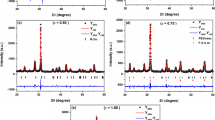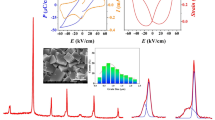Abstract
(100−x) at.% Ba0.6Sr0.4TiO3−x at.% Y2O3 (BST/Y2O3) composite ceramics were prepared by conventional solid-state reaction methods. Phase constitution, microstructure, and element distribution of the composite ceramics were characterized, and the dielectric properties of BST/Y2O3 composite ceramics were measured. The results revealed that some of Y3+ were dissolved into the lattice of BST and the rest remained at grain boundaries in oxide form of Y2O3. With the increase of the content of Y2O3, Curie peak of BST/Y2O3 composite ceramics moved to a lower temperature, the dielectric permittivity and dielectric loss of BST/Y2O3 composite ceramics decreased significantly, meanwhile, the dielectric tunability still maintains a relatively high value. Furthermore, a multipolarization mechanism model is employed to describe the field dependence of the dielectric permittivity in BST/Y2O3 composite, which suggests that the existence of the second phase of Y2O3 diminishes the contribution of polar clusters in BST matrix, leading to the decrease of dielectric tunability. P–E loop measurement indicates that the breakdown strength of BST/Y2O3 ceramics increases during addition of Y2O3 in BST matrix. Therefore, the BST/Y2O3 composites with good tunable dielectric properties and enhanced breakdown strength can be exploited for phase shifter and capacitor device applications.








Similar content being viewed by others
References
Tagantsev AK, Sherman VO, Astaev KF, Venkatesh J, Setter N (2003) ferroelectric materials for microwave tunable applications. J Electroceram 11:5–66
Nenasheva EA, Kanareykin AD, Kartenko NF, Dedyk AI, Karmanenko SF (2004) Ceramics materials based on (Ba, Sr)TiO3 solid solutions for tunable microwave devices. J Electroceram 13:235–238
Cole MW, Hubbard C, Ngo E, Ervin M, Wood M, Geyer RG (2002) Structure–property relationships in pure and acceptor-doped Ba1−xSrxTiO3 thin films for tunable microwave device applications. J Appl Phys 92:475–483
Su B, Button TW (2004) Microstructure and dielectric properties of Mg-doped barium strontium titanate ceramics. J Appl Phys 95:1382–1385
Kim WJ, Chang W, Qadri SB, Pond JM, Kirchoefer SW, Chrisey DB, Horwitz JS (2000) Microwave properties of tetragonally distorted (Ba0.5Sr0.5)TiO3 thin films. Appl Phys Lett 76:1185–1187
Subramanyam G, Cole MW, Sun NX et al (2013) Challenges and opportunities for multi-functional oxide thin films for voltage tunable radio frequency/microwave components. J Appl Phys 114:191301
Sengupta LC, Sengupta S (1999) Breakthrough advances in low loss, tunable dielectric materials. Mater Res Innov 2:278–282
Wang JW, Xu C, Shen B, Zhai JW (2013) Enhancing energy storage density of (Ba, Sr)TiO3 ceramic particles by coating with Al2O3 and SiO2. J Mater Sci 24:3309–3314. doi:10.1007/s10854-013-1248-5
Herner SB, Selmi FA, Varadan VV, Varadan VK (1993) The effect of various dopants on the dielectric properties of barium strontium titanate. Mater Lett 15:317–324
Hu T, Price TJ, Iddles DM, Uusimaki A, Jantumen H (2005) The effect of Mn on the microstructure and properties of BaSrTiO3 with B2O3–Li2CO3. J Eur Ceram Soc 25:2531–2535
Garcia S, Font R, Portelles J, Quinones RJ, Heiras J, Siqueiros JM (2001) Effect of Nb doping on (Sr, Ba)TiO3 (BST) ceramic samples. J Electroceram 6:101–108
Kim KT, Kim C (2004) The effect of Cr doping on the microstructural and dielectric properties of (Ba0.6Sr0.4)TiO3 thin films. Thin Solid Films 472:26–30
Kim JK, Kim SS, Kim WJ, Ha TG, Kim IS, Song JS, Guo R, Bhalla AS (2006) Improved ferroelectric properties of Cr-doped Ba0.7Sr0.3TiO3 thin films prepared by wet chemical deposition. Mater Lett 60:2322–2325
Liang CS, Wu JM (2005) Electrical properties of W-doped (Ba0.5Sr0.5)TiO3 thin films. J Cryst Growth 274:173–177
Lee SG, Kang DS (2003) Effect of molar ratio of KOH to Ti-isopropoxide on the formation of BaTiO3 powders by hydrothermal method. Mater Lett 57:1629–1634
Hu GX, Gao F, Liu LL, Cao X, Liu ZT (2011) Microstructure and dielectric properties of Ba0.6Sr0.4TiO3–MgAl2O4 composite ceramics. Ceram Int 37:1321–1326
Liang RH, Zhou ZY, Dong XL, Wang GS, Cao F, Hu ZG, Jiang K (2015) Enhanced dielectric tunability of Ba0.55Sr0.45TiO3–ZnAl2O4 composite ceramic. Ceram Int 41:S551–S556
Chen Y, Zhang YY, Dong XL, Wang GS, Cao F (2010) Microstructure-dielectric properties relationship in Ba0.6Sr0.4TiO3–Mg2SiO4–Al2O3 composite ceramics. J Am Ceram Soc 93:161–166
He Z, Liu BX, Li CN, He YY, Zeng CL, Li BY, Sun YZ, Xu YB (2015) Microstructures and dielectric tunable properties of Ba0.5Sr0.5TiO3–MgO–Mg3B2O6 composite ceramics. Ceram Int 41:6286–6292
Zheng JX, Ceder G, Maxisch T, Chim WK, Choi WK (2006) Native point defects in yttria and relevance to its use as a high-dielectric-constant gate oxide material: first-principles stud. Phys Rev B 73:104101
Wilk GD, Wallace RM, Anthony JM (2001) High-k gate dielectrics: current status and materials properties considerations. J Appl Phys 89:5243–5275
Wu L, Wang X, Gong H, Hao Y, Shen Z, Li L (2015) Core-satellite BaTiO3@SrTiO3 assemblies for a local compositionally graded relaxor ferroelectric capacitor with enhanced energy storage density and high energy efficiency. J Mater Chem C 3:750–758
Inthong S, Tunkasiri T, Rujijanagul G, Pengpat K, Kruea-In C, Intatha U, Eitssayeam S (2015) Dielectric, mechanical, and microstructural characterization of HA–BST composite ceramics. Ceram Int 41:S481–S486
Ang C, Yu Z (2004) dc electric-field dependence of the dielectric constant in polar dielectrics: multipolarization mechanism model. Phys Rev B 69:174109
Acknowledgements
This work was financially supported by National Natural Science Foundation of China (No. 51402234), Natural Science Basic Research Plan (Nos. 2015JQ5198, 2015JQ5142), and Young Talent fund of University Association for Science and Technology (20150106) in Shaanxi Province, the doctoral starting fund (No. 101-211408) and New-Star of science and technology (101-256101511) of Xi’an University of Technology.
Author information
Authors and Affiliations
Corresponding author
Rights and permissions
About this article
Cite this article
Wang, Q., Ren, P., Sun, L. et al. Microstructure and tunable dielectric properties of Ba0.6Sr0.4TiO3/Y2O3 composite ceramics. J Mater Sci 51, 6249–6256 (2016). https://doi.org/10.1007/s10853-016-9922-7
Received:
Accepted:
Published:
Issue Date:
DOI: https://doi.org/10.1007/s10853-016-9922-7




